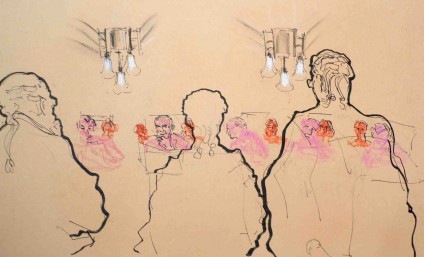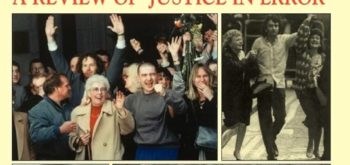Sexual abuse allegations against celebrities have featured heavily in the UK media since the broadcasting of the Exposure documentary on Jimmy Savile in October 2012. Now, and in the future, a number of questions may be asked about this phenomenon. Indeed, the most recent case of Cliff Richard’s house being raided by police in his absence under media spotlight has provoked a powerful riposte from Geoffrey Robertson QC here. Both the BBC and South Yorkshire Police are being asked to account for their actions.
The understandable public revulsion that attaches to reports of some celebrities and other public figures misusing their status to sexually abuse has inhibited legitimate questioning over the implications for justice processes that flow from the actions of the police, the media and public prosecutors in such high-profile cases. The prevailing master narrative is buttressed by seemingly authoritative reports such as Giving Victims a Voice (Gray and Watt, 2013). ‘Any master narrative, however, for all its claims to objectivity and veracity, is only one partisan version of many possible accounts’ (Butler and Drakeford, 2005: 235). The same authors go on to note that ‘dissenting and questioning voices are to be discovered, submerged beneath the dominant discourse.’ (2005: 137).
The Economic and Social Research Council has provided us with funding to secure a dataset that will allow us to bring to the surface some of the submerged narratives that exist in relation to the most notorious of such cases – that of Jimmy Savile.
- This article is co-authored by Mark Smith, Steve Kirkwood, Clare Llewellyn of the University of Edinburgh and Ros Burnett of the University of Oxford
- You can read about their project here
Pivotal allegations, following Jimmy Savile’s death, that led to the exposure of Savile as a prolific sex offender related to his visits to Duncroft Residential School in the South of England in the 1970s, and the accounts of some former residents that he sexually abused them there and while on visits to television studios. Duncroft was established by the Home Office in the 1960s as an ‘approved school’ to give a second chance at education to girls who were identified as intelligent but who, for whatever reason, usually relating to difficult family circumstances and/ or behavioural issues, had encountered social and educational difficulties. One former Duncroft pupil blogs on the internet here. A writer and socio-legal professional, she herself has investigated and blogged on the Savile case, and her blogs have generated a great deal of further online discussion and further accounts and informants.
Our research project involves the collection and archiving of this social media content in addition to gathering testimony and documents relating to Duncroft, particularly during the time of Savile’s visits. The research was funded through an ‘urgent’ call from the ESRC, on the grounds that some of the key informants are now elderly or unwell and therefore time is of the essence. The research will gather data that would otherwise be lost, bringing together a range of alternative sources and accounts that may allow for more balanced and grounded conclusions to be drawn on the Savile case, and its legal and policy implications, once the initial hysteria has dissipated.
Undertaking research of this nature raises a number of issues and indeed some may say that the research should not be undertaken at all, lest it be seen to dismiss the accounts and hence the experiences and identities of those claiming abuse. At its heart, however, the project confronts major issues of justice related to the presumption of innocence, the status of complainants’ accounts, adherence to legal principles and the rule of law several decades after the alleged offences and the defamation of the dead. At another level, it also tells us something about a persistent notion of ‘evil’ in contemporary culture. This project also presents challenges regarding practical, legal and ethical aspects of digital archiving, particularly when it comes to social media materials and anonymity.
Innocence and victim accounts
Allegations against Savile were never made in a court of law. Yet legislation and policy and public opinion have been changed in ways that fundamentally affect due process when others are accused of historical abuse. As highlighted in an article by Marcus Soanes and Robert McPeake (here), there has been a recent trend to label ‘complainants’ or ‘accusers’ as ‘victims’, even before a complaint has gone to trial. This has been clearly evident in Operation Yewtree – the main investigation in relation to sexual abuse allegations against Jimmy Savile and other high-profile figures – whereby the report Giving Victims a Voice stated:
On the whole victims are not known to each-other and taken together their accounts paint a compelling picture of widespread sexual abuse by a predatory sex offender. We are therefore referring to them as ‘victims’ rather than ‘complainants’ and are not presenting the evidence they have provided as unproven allegations.
Similarly, as part of Operation Outreach, Surrey Police contacted former Duncroft pupils to invite testimony regarding Savile’s activities at the school and towards its residents (here), stating:
Please be assured that the welfare of victims is the primary concern of both Surrey Police and Barnardo’s. This is a search for the truth and you will be believed.
On the one hand, such assurances are valuable in enabling victims of abuse who may have been disbelieved in the past to speak out in confidence that they will now be heard and their allegations taken seriously. On the other hand, treating claims as facts and accusers as victims while raising the expectation of those who make allegations that these do not need to be verified is contrary to the ‘presumption of innocence until proven guilty’ and other legal principles. As discussed by Ros Burnett on www.thejusticegap.com (here), over-correcting for systematic disbelief of complainants in the past by now systematically believing them all is creating new injustices, which are equally deserving of concern. False positives and false negatives are both problematic. An added complexity is the ‘guilty’ verdict imposed on those who are dead. The individuals are then universally condemned even though these allegations will never be tested in a criminal court.
What is particularly disturbing about the Savile case is that the posthumous verdict – that he was a serial child molester on a massive scale, who got away with it because people turned a blind eye or were foolishly naïve – has become the justification for now erring on the side of treating all accusations as credible. The determination that there shall never be another Savile has galvanised aggressive policing operations which can terrorise suspects and their families and has justified procedural changes to make it easier to arrest, detain, and convict people for child sexual abuse whether they are guilty or innocent. For these reasons, questioning accounts and defending voices deserve to be heard as well as the voices of accusers.
Sexual abuse and evil
Child sexual abuse is considered among the most reprehensible crimes a person can commit. Because of its nature, those who commit these crimes are often associated with notions of ‘evil’. As argued by Mark Smith (here) when behaviours are described as ‘evil’ they justify extraordinary responses – crimen exceptum – such as the removal of due process and dropping normal evidential standards. Similarly, Mark Barlow and Mark Newby (here) drew on Richard Webster’s book The Secrets of Bryn Estyn: The Making of a Modern Witch Hunt to highlight that categorising certain crimes as ‘evil’ can lead to witch hunt-style moral crusades, whereby those accused are dehumanised and normal justice processes are suspended or rendered impossible. Such events tell us a lot about how society understands childhood and sexual abuse, while demonstrating the ways that religious ideas, such as ‘evil’, are transformed and persist in seemingly secular contemporary contexts.
Social media and digital archiving
A central aspect of our project involves research based on social media which, of course, contains a vast array of both information and misinformation. The project has also forced us to explore some cutting edge issues that are involved in seeking to gather and archive information, specifically relating to questions around ownership. If something is made publicly available through social media, does that make it fair game for social researchers and digital archivists? If the blog owner gives express permission for their work to be included in the research project, does that extend to the comments that other people make on their posts?
Anonymity is clearly another issue for a project such as this. In general, those who have made sexual abuse allegations against Savile have had their anonymity maintained. On the one hand, research participant anonymity is a core aspect of ethical social science research. On the other hand, being able to identify individuals may be essential for verifying and cross-checking information to test its veracity. These issues need to be carefully explored and managed in order to ensure that the project is both ethical and robust.
Conducting research on high-profile historic sexual abuse
Undertaking research that questions accounts and justice processes in relation to something as sensitive as sexual abuse is dangerous. At one level it has the potential to be used by those who may wish to deny the reality of sexual abuse and its repercussions. This is a legitimate consideration but it cannot be the only one. It is equally dangerous to moralise a subject and to treat it as out of bounds for scrutiny. Personifying individuals like Savile within an idiom of evil amounts to ‘intellectual laziness, shutting off inquiry and the proper search for context’ (Frankfurter, 2006: 11-12). Frankfurter goes further. He cautions that ‘the real atrocities of history seem to take place not in the perverse ceremonies of some evil cult but in the course of purging such cults from the world’. The real danger in failing to undertake proper research on such sensitive subjects is that central tenets of a balanced and humane justice system become fatally compromised.
References
Barlow, M. & Newby, M. (2012). Savile, Bryn Estyn and the danger of modern witch-hunts
Burnett, R. (2013). Default belief.
Butler, I. & Drakeford, M. (2005). Scandal, social work and social welfare. The Policy Press: Bristol.
Frankfurter, D. (2008). Evil incarnate: Rumors of demonic conspiracy and satanic abuse in history. Princeton University Press: Princeton, NJ.
Gray, D. & Watt, P. (2013). Giving victims a voice: Joint report made into sexual allegations against Jimmy Savile (PDF)
Smith, M. (2013). Panicking over the past
Soanes, M. & McPeake, R. (2014). Labelling all accusers ‘victims’ will pervert the course of justice
Webster, R. (2005). The secret of Bryn Estyn: The making of a modern witch hunt. Orwell Press: Oxford.







